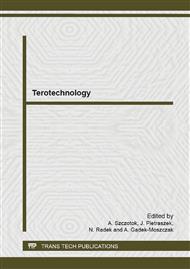[1]
J. Bednarczyk, Promising strategies for a technology utilizing an energetic brown coal under strong limitation of the carbon dioxide emission, R49 (2007) (5-6) 25-34.
Google Scholar
[2]
J. Bednarczyk, Development scenarios for Legnica brown coal deposit., The technology for access to Legnica brown coal deposit, Redakcja Górnictwa Odkrywkowego, Wrocław (2007).
Google Scholar
[3]
J.A. Maxson, Managing new mercury limits requires delicate balance, 12 (2001) 12-24.
Google Scholar
[4]
B. Klojzy-Karczmarczyk, J. Mazurek, Soil contamination by mercury compounds in influence zone of coal-based power plant, 10 (2007) (2) 593-600.
Google Scholar
[5]
J. Kwasniewski, I. Dominik, K. Lalik, Application of self-oscillating system for stress measurement in metal, J. Vibroeng. 14 (2012) (1) 61-66.
Google Scholar
[6]
P. Osocha, P. Duda, B. Weglowski, Determining temperature and stress changes in thick-walled elements of steam lines, Inz Chem Procesowa 25 (2004) (4) 2249-2256.
Google Scholar
[7]
B. Weglowski, P. Osocha, Modelling of Creep for Y Pipe from Ferritic-Martensitic P91 Steel, Rynek Energii (2009) (6) 140-145.
Google Scholar
[8]
M. Pronobis, Modernization of power boilers, WNT, Warszawa 2002 (in Polish).
Google Scholar
[9]
J. Szargut, A. Ziębik, Fundamentals of thermal energy, PWN, Warszawa 1998 (in Polish).
Google Scholar
[10]
W. Wojnar, M. Pronobis, The Model of Flow and Temperature Distribution in the Superheater of a Power Boiler, Rynek Energii (2008) (6) 39-46.
Google Scholar
[11]
H. Majchrzak, Influence analysis of the power unit startup and shutdown technology for the energy losses and startup costs, Ph.D. Thesis., Opole University of Technology, Opole (2001).
Google Scholar
[12]
D. Kirmse, S. Lysk, A. Kather, G. Scheffknecht, Betriebserfahrungen mit den beiden 800 MW Dampferzeugern im Kraftwerk Schwarze Pumpe, 6 (2000) 29-38.
Google Scholar
[13]
P. Duda, J. Taler, E. Roos, Inverse Method for Temperature and Stress Monitoring in Complex-Shape-Bodies, 3960 1-17., 3960 (2003) 1-17.
Google Scholar
[14]
J. Taler, P. Duda, Solving Direct and Inverse Heat Conduction Problems, Springer, Berlin Heidelberg (2006).
DOI: 10.1007/978-3-540-33471-2
Google Scholar
[15]
J. Taler, B. Węglowski, S. Grądziel, P. Duda, W. Zima, Monitoring of Thermal Stresses in Pressure Components of Large Steam Boilers, VGB Kraftwerk-sTechnik 1(2002), 73-78.
DOI: 10.1007/978-94-007-2739-7_396
Google Scholar
[16]
TRD 301 Anlage 1: Technische Regeln für Dampfkessel: Berechnung auf Wechselbeanspruchung durch schwellenden Innendruck bzw. durch kombinierte Innendruck und Temperaturänderungen, Carl Heymans Verlag, Köln, und Beuth-Verlag, Berlin Ausgabe (1986).
DOI: 10.1002/cite.330500725
Google Scholar
[17]
PN-EN 12952-3: 2004: Water tube boilers and auxiliary installations. Part 3: Design and calculation for pressure parts. (in Polish).
DOI: 10.3403/02574723
Google Scholar
[18]
Bid documentation: Medium-pressure valves PN40 i PN100 – model SPK1 and SKS1. Second edition. No 021. 25. 2, Chemar, Kielce 2002 (in Polish).
Google Scholar
[19]
Maintenance manual: Medium Pressure Valves PN40 and PN100 – model SPK1 and SKS1. Third edition. No 021. 94. 1, Chemar, Kielce 2001 (in Polish).
Google Scholar
[20]
R. Dwornicka, The Calculation of Allowable Cooling and Heating Rates for a Gate Valve SKS1 Made from Steel 13 HMF WDG TRD., in: A.T. Bogorosz, A. Bubulis, R.I. Silin, V.P. Royzman and W.M. Sokol, (Eds. ), Modern Achievements in Science and Education, Khmelnitsky National University, Khmelnitsky (2008).
Google Scholar
[21]
P. Duda, R. Dwornicka, Optimization of heating and cooling operations of steam gate valve, Struct Multidisc Optim 40 (2010) 529-535.
DOI: 10.1007/s00158-009-0370-8
Google Scholar
[22]
J. Pietraszek, N. Radek, K. Bartkowiak, Advanced Statistical Refinement of Surface Layer's Discretization in the Case of Electro-Spark Deposited Carbide-Ceramic Coating Modified by a Laser Beam, Solid State Phenom. 197 (2013) 198-202.
DOI: 10.4028/www.scientific.net/ssp.197.198
Google Scholar
[23]
J. Pietraszek, A. Gądek-Moszczak, The Smooth Bootstrap Approach to the Distribution of a Shape in the Ferritic Stainless Steel AISI 434L Powders, Solid State Phenom. 197 (2013) 162-167.
DOI: 10.4028/www.scientific.net/ssp.197.162
Google Scholar
[24]
D.C. Montgomery, Design and Analysis of Experiments, John Wiley & Sons, Hoboken, (2008).
Google Scholar
[25]
J. Pietraszek, Response surface methodology at irregular grids based on Voronoi scheme with neural network approximator, Adv. Soft Comput. 19 (2003) 250-255.
DOI: 10.1007/978-3-7908-1902-1_35
Google Scholar
[26]
T. Styrylska, J. Pietraszek, Numerical modeling of non-steady-state temperature fields with supplementary data, Z. Angew. Math. Mech. 72 (1992) T537-T539.
Google Scholar


